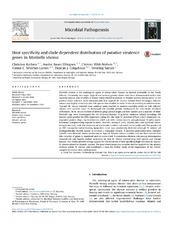| dc.contributor.author | Karlsen, Christian | eng |
| dc.contributor.author | Ellingsen, Anette Bauer | eng |
| dc.contributor.author | Wiik-Nielsen, Christer R. | eng |
| dc.contributor.author | Winther-Larsen, Hanne C. | eng |
| dc.contributor.author | Colquhoun, Duncan John | eng |
| dc.contributor.author | Sørum, Henning | eng |
| dc.date.accessioned | 2015-03-25T12:37:19Z | |
| dc.date.available | 2015-03-25T12:37:19Z | |
| dc.date.issued | 2014-12 | eng |
| dc.identifier.issn | 0882-4010 | en_US |
| dc.identifier.uri | http://hdl.handle.net/1956/9644 | |
| dc.description.abstract | Moritella viscosa is the aetiological agent of winter-ulcer disease in farmed salmonids in the North Atlantic. Previously, two major (typical and variant) genetic clades have been demonstrated within this bacterial species, one of which is almost solely related to disease in Atlantic salmon (Salmo salar). In the present study infection trials demonstrated that ‘typical’ M. viscosa isolated from Norwegian Atlantic salmon was highly virulent in this fish species but resulted in lower levels of mortality in rainbow trout. ‘Variant’ M. viscosa isolated from rainbow trout resulted in modest mortality levels in both Atlantic salmon and rainbow trout. To investigate the possible genetic background for inter-strain virulence differences, 38 M. viscosa isolates of diverse geographical origin and host species and a number of other Moritella spp. were investigated for the presence/absence of putative virulence related homologs. All isolates were positive for DNA sequences coding for; the Type VI secretion ATPase (clpV), hemolysin co-regulated protein (hcp), bacterioferritins (bfrA and bfrB), lectin (hemG), phospholipase D (pld), multifunctional autoprocessing repeats-in-toxin (martxA), aerolysin (aer), invasin (inv), and cytotoxic necrotizing factor (cnf), with the exception of one isolate in which cnf could not be confirmed. The product of an ABC transporter metal-binding lipoprotein (mat) was consistently detected although 11 isolates, all phylogenetically related, appear to produce a truncated version. A putative insecticidal toxin complex (mitABC) was detected almost exclusively in ‘typical’ Atlantic salmon isolates, and our data indicate that this complex of genes is expressed and co-transcribed. Transmission electron microscopy investigation revealed pili and flagella surface structures on nine M. viscosa representing both typical and variant isolates. Our results provide strong support for the existence of host specificity/high virulence in ‘typical’ M. viscosa related to Atlantic salmon. The gene distribution also provides further support for the genetic division within M. viscosa, and constitutes a basis for further study of the importance of the mitABC complex in winter-ulcer pathogenesis. | en_US |
| dc.language.iso | eng | eng |
| dc.publisher | Elsevier | en_US |
| dc.rights | Attribution-NonCommercial-NoDerivs CC BY-NC-ND | eng |
| dc.rights.uri | http://creativecommons.org/licenses/by-nc-nd/3.0/ | eng |
| dc.subject | Moritella viscosa | eng |
| dc.subject | Winter-ulcer disease | eng |
| dc.subject | Host specificity | eng |
| dc.subject | Atlantic salmon | eng |
| dc.subject | Virulence genes | eng |
| dc.title | Host specificity and clade dependent distribution of putative virulence genes in Moritella viscosa | en_US |
| dc.type | Peer reviewed | |
| dc.type | Journal article | |
| dc.date.updated | 2015-03-04T08:08:06Z | en_US |
| dc.description.version | publishedVersion | en_US |
| dc.rights.holder | Copyright 2014 The Authors | en_US |
| dc.identifier.doi | https://doi.org/10.1016/j.micpath.2014.09.014 | |
| dc.identifier.cristin | 1202421 | |
| dc.source.journal | Microbial Pathogenesis | |
| dc.source.40 | 77 | |
| dc.source.pagenumber | 53-65 | |
| dc.subject.nsi | VDP::Mathematics and natural scienses: 400::Basic biosciences: 470::Genetics and genomics: 474 | en_US |
| dc.subject.nsi | VDP::Matematikk og naturvitenskap: 400::Basale biofag: 470::Genetikk og genomikk: 474 | nob |

